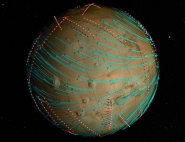CNES projects library
C
I
M
P
S
U
Bi
Maven
Why is the atmosphere of Mars, once dense and probably rich in water and carbon dioxide, today so tenuous? This is the enigma the MAVEN spacecraft is attempting to solve since arriving in its working orbit around the Red Planet on 16 November 2014, after a 10-month journey, in an effort to retrace the history of Mars’ atmosphere and climate. MAVEN is exploring Mars’ upper atmosphere and analysing how it interacts with the Sun and the solar wind, acquiring measurements from its 4½-hour elliptical orbit, at altitudes varying from 150 km to 6,000 km. It has also flown a series of ‘deep dips’ into the upper atmosphere, as low as 125 km from the planet’s surface, to analyse its composition. To accomplish all of these tasks, MAVEN is carrying a suite of eight scientific instruments.
Undertaken in partnership with France, MAVEN is a mission of NASA’s Mars Scout programme. CNES oversaw instrument development by French research laboratories. In particular, the IRAP astrophysics and planetology research institute in Toulouse developed and supplied the Solar Wind Electron Analyzer (SWEA), one of MAVEN’s eight instruments. The mission was originally scheduled to run for one Earth year, with an option to extend it to one Mars year (686 days). It has since been further extended and is still operational.
In February 2019, the mission embarked on a new aerobraking phase to tighten MAVEN’s orbit and ready it to serve as a data-relay satellite for rovers on the surface of Mars. This phase will involve another series of deep dips to within 125 km of the surface, enabling further in-situ analyses. By April, it will have reduced the highest point (apoapsis) of MAVEN’s orbit to 4,500 km.
Mission's news feed
-

NASA’s MAVEN maps winds in the Martian upper atmosphere
Researchers have created the first map of wind circulation in the upper atmosphere of a planet besides Earth, using data from NASA’s MAVEN spacecraft that were collected during...
February 3, 2020
-

MAVEN Used Mars’ Atmosphere to reach it’s final orbit
Maven used aerobreaking to tighten it’s orbit to act as a telecommunications relay.
April 25, 2019
-

MAVEN entered orbit around the Red Planet on September 21, 2014
NASA's Mars Atmosphere and Volatile Evolution (MAVEN) spacecraft successfully entered Mars' orbit at 10:24 p.m. EDT Sunday, Sept. 21, completing an interplanetary...
September 25, 2014


